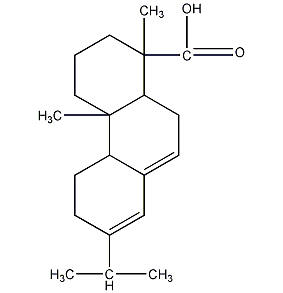
Structural formula
| Business number | 05B3 |
|---|---|
| Molecular formula | C20H30O2 |
| Molecular weight | 302.45 |
| label |
abietic acid, ripe rosin, 1,2,3,4,4A,4B,5,6,10,10A-decahydro-1,4A-dimethyl-7-isopropyl-1-phenanthrenecarboxylic acid, Rosin acid; resin acid, Sylvic acid, 13-iso-Propylpodocarpa-7,13-dien-15-oic acid, 1,2,3,4,4a,4b,5,6,10,10a-Decahydro-1,4a-dimethyl-7-(1-methylethyl)-,[1R-(1.alpha.,4a.beta. ,4b.al1-Phenanthrenecarboxylic acid, 13-Isopropyl-podocarpa-13-dien-15-oicacid, Rosin, polymeric emulsifiers, plasticizer, tackifier, Optical dividing agent |
Numbering system
CAS number:514-10-3
MDL number:MFCD03423567
EINECS number:208-178-3
RTECS number:TP8580000
BRN number:2221451
PubChem number:24891449
Physical property data
1. Properties: slightly yellow to yellow-red glassy solid.
2. Density (g/mL, 25/4℃): 1.067
3. Relative vapor density (g/mL, air=1): Undetermined
4. Melting point (ºC): 172~175℃
5. Boiling point (ºC, normal pressure): 300
6. Boiling point (ºC, 5.2kPa): Not available Determine
7. Refractive index: 1.5453
8. Flash point (ºC): 216
9. Specific rotation (º, C=1, None Water ethanol): -106
10. Autoignition point or ignition temperature (ºC): Undetermined
11. Vapor pressure (kPa, 25ºC): Undetermined
12. Saturated vapor pressure (kPa, 60ºC): Undetermined
13. Heat of combustion (KJ/mol): Undetermined
14. Critical temperature (ºC): Undetermined
15. Critical pressure (KPa): Undetermined
16. Log value of oil-water (octanol/water) partition coefficient: Undetermined
17. Explosion upper limit (%, V/V): Undetermined
18. Explosion lower limit (%, V/V): Undetermined
19. Solubility: Insoluble in water, slightly soluble in hot water, easily soluble in ethanol, ether, acetone, benzene, dichloroethane, carbon disulfide, turpentine, petroleum ether, gasoline and other organic solvents, and soluble in oils and alkaline solution. 20. Softening point (Globe and Ball method): 72~74℃
21. Ignition point: 480~500℃
Toxicological data
None yet
Ecological data
This substance may be harmful to the environment, and special attention should be paid to water bodies.
Molecular structure data
1. Molar refractive index: 89.48
2. Molar volume (cm3/mol): 284.5
3. Isotonic specific volume (90.2K ): 719.0
4. Surface tension (dyne/cm): 40.7
5. Polarizability (10-24cm3): 35.47
Compute chemical data
1. Reference value for hydrophobic parameter calculation (XlogP): 4.8
2. Number of hydrogen bond donors: 1
3. Number of hydrogen bond acceptors: 2
4. Number of rotatable chemical bonds: 2
5. Number of tautomers: none
6. Topological molecule polar surface area 37.3
7. Number of heavy atoms: 22
8. Surface charge: 0
9. Complexity: 542
10. Number of isotope atoms: 0
11. Determine the number of atomic stereocenters: 4
12. Uncertain number of atomic stereocenters: 0
13. Determine the number of chemical bond stereocenters: 0
14. Number of uncertain chemical bond stereocenters: 0
15. Number of covalent bond units: 1
Properties and stability
1. Use and store according to specifications. It will not decompose and avoid contact with oxides.
2. It is not highly toxic, but its vapor can cause acute poisoning symptoms such as headache, dizziness, coughing, and asthma. During production, you should pay attention to wearing masks and other anti-virus supplies, and the workplace should have good ventilation conditions.
3.Esterification reaction with alcohol to produce esters; with Sodium hydroxide, potassium hydroxide and sodium carbonate work to produce sodium rosinate or potassium rosinate. Rosin is easily oxidized when exposed to air and turns dark brown in color.
4. Is irritating.
Storage method
1. Sealed and stored at low temperature, it should be stored in a cool, ventilated, cool and dry place, protected from fire and heat.
2. Packed in cardboard boxes or wooden boxes lined with paper bags. Avoid heat and light to prevent oxidation and deterioration. Pay attention to fire prevention and stay away from oxidants and acid and alkali items.
3. Store in a cool, dry place. Transport according to regulations for flammable chemicals.
4. Sealed with nitrogen and stored at 0-4ºC.
Synthesis method
(1) Use rosin as raw material to get rosin from live pine trees, add the rosin to the reactor, heat and melt, then pass water vapor, conduct steam distillation, steam out the residual turpentine, filter at about 210°C, and cool to crystallize The finished product is obtained.
(2) Using pine wood fragments as raw materials, crush and screen the pine wood fragments, impregnate them with gasoline, then filter and decolorize the impregnation liquid, recover the solvent, and distill under reduced pressure to obtain the finished product.
(3)Add the rosin removed from the pine tree into the reactor, heat and melt it, then pass water vapor through it, conduct steam distillation, and steam out The residual liquid of turpentine is filtered at about 210°C and cooled to crystallize to obtain the finished product. Or crush the pine wood fragments, screen them, and impregnate them with gasoline. Then filter the impregnation liquid, decolorize it, recover the solvent, and distill it under reduced pressure to obtain the finished product.
Purpose
1. Assist the growth of lactic acid bacteria and butyric acid bacteria. fermentation industry. Starting materials for the synthesis of natural products. Methyl, vinyl and glyceryl esters of dehydroabietic acid are used in natural lacquers and varnishes. Its heavy metal salt can be used as a desiccant. 2. After being saponified with sodium hydroxide, it can be converted into sodium salt and can be used as a polymerization emulsifier for styrene-butadiene rubber, chloroprene rubber, etc. It can also be used as a rubber plasticizer, a tackifier for adhesives, a sizing compound for high-grade paper, and an ingredient for chewing gum. 3.It is used as a sizing material in the papermaking process, and can also be used as a pesticide emulsifier and textile sizing agent.Lubricant for construction materials, plasticizer for plastics and rubber, and drier for coatings. 4.Abietic acid, tetrahydroabietic acid and their salts are safe and harmless cosmetic additives recognized by CTFA. Extremely strong antibacterial effect, 3×10-6 can effectively inhibit the activity of Streptococcus bacteria. Mixed with vitamin E and olive oil, it can treat severe burns and skin diseases, such as psoriasis. It can be used in facial products and medicinal effects to prevent acne. toothpaste. It has a conditioning and modification effect on the hair. It can be used as an auxiliary in perm water to prevent damage to the hair. 5. Production of vinegar, such as methyl rosin acid, glyceryl rosin acid, etc. Production of paints and engineering plastics, etc.


